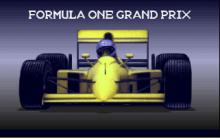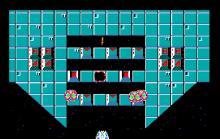Defender
How to play Defender
Each game uses different controls, Games can a combination of mouse,keyboard and Joystick.
Defender Description
Defender is a horizontally-scrolling shoot 'em up arcade game created by Williams Electronics in 1980. It was designed and programmed by Eugene Jarvis (who later formed Vid Kidz and made more of Williams' hits), Larry DeMar, Sam Dicker, and Paul Dussault. This game was a hit when it was released and remained popular throughout the 1980s.
The player flies a small spaceship above a long, mountainous landscape (in all versions, except the Atari 2600 edition due to memory limitations; in that case, the landscape consisted of a city represented by buildings). The land is inhabited by a small number of humans. The landscape wraps around, so flying constantly in one direction will eventually bring the player back to their starting point. The players ship can fly through the landscape without being destroyed.
A number of flying aliens reside in the air above the landscape. The player's responsibilities are twofold:
Destroy all aliens
Protect the humans from being captured
The player is armed with a beam-like weapon which can be fired rapidly in a long horizontal line ahead of the spaceship, and also has a limited supply of smart bombs (three, to begin with), which can destroy every enemy on the screen.
At the top of the screen is a radar-like scanner, which displays the positions of all aliens and humans on the landscape.
Aliens
File:Defenderaliens.png
Defender's attract mode shows the various types of aliens featured in the game.
There are six types of aliens in total:
Lander - The primary enemy on every level. Landers teleport into the level in staggered waves. They attempt to capture humans by descending upon them and dragging them into the air; if they make it to the top of the screen with a human, the two fuse together into a more dangerous Mutant. Landers can fire projectiles at the player.
Mutant - A mutated Lander. Mutants home in on the player at constant speed, firing projectiles. They move erratically, making them difficult to shoot.
Baiter - A flat, iridescent spacecraft that teleports in if the player is taking too long to complete a level. Homes in on the player and attempts to match their speed, whilst firing accurate projectiles. A difficult opponent due to its unbeatable speed and tiny vertical cross-section, which makes it very hard to shoot.
Bomber - A box-shaped alien that lays stationary mines in the air.
Pod - A star-like alien that bursts into a number of Swarmers when shot.
Swarmer - A tiny teardrop-shaped alien that moves very quickly in an undulating fashion. Difficult to shoot.
Once all aliens (except Baiters) are destroyed, the player progresses to the next level.
Humans
The game starts with ten humans inhabiting the land. Landers will attempt to capture and fuse with these during play.
To rescue a human from capture, the player must shoot the Lander holding it while it is in the air, causing the human to drop back to the ground. At low height humans can survive the drop on their own, but if the Lander is killed at too high an altitude, the player must catch the human with their own ship and return them to the ground, otherwise the human will not survive the drop.
The humans can be killed by the player's weapon just as easily as the aliens can, so careful aim is required when firing near them.
If all humans are killed, the entire planet explodes, leaving the player in empty space. This also has the unfortunate effect of turning every Lander into a Mutant, making the player's job very difficult.
All ten humans are replenished every fifth wave, starting with wave five. If the planet explodes, the player has to survive mutant-filled waves until the next multiple of five wave arrives, when the planet will be restored.
At the time Eugene Jarvis first came to the company, Williams was just about to make their move into the fledgling video game market. Eventually, Jarvis was given the job of developing the project. As the project progressed, he eventually got other people involved in the game's development (including Larry DeMar, with whom he would later co-found their company, Vid Kidz). Defender was developed using the "Exorcisor", a computer from Motorola that Jarvis describes as "the most bloated, overpriced computer ever created".
Jarvis initially worked on the game on his own, added the scrolling land, and added some humans on the land, but lacked a narrative. One night while falling asleep he dreamt of the aliens following the land and picking up the humans and carrying them off and then turning into mutants, with the player trying to stop them. He had his game.
Initially the game was too easy, like flying in a tank of water, but the gameplay picked up considerably when 'baiters' were added which appeared after a set time period; the baiters kept the player under constant time pressure to finish the level; giving a sweaty hand feeling.
At one point, when the game was nearly complete, the highest score anyone had ever managed was 50,000 points, and many people thought that this was a fluke. Indeed, the development team almost didn't add extra levels, since they thought that nobody would reach them, the game was judged to be ridiculously hard.
When the time came for the game to make its debut at the AMOA trade show, the game still wasn't complete. The game had everything: its complex controls, its cabinet graphics, and the Defender marquee. However, it was missing one important thing: the ROM chip that actually contained the game.
When the game was finally finished, the machine wouldn't come on the first time the ROM chips were inserted, they accidentally plugged them in upside-down and destroyed the chips in the process, however when the ROMs were "burned" (the method of transferring the game from the development computer to the arcade machine's ROM chips) a second time, it did come on. Unfortunately, nobody would play the game; because of its complex controls, many of the showgoers felt that the game was too complicated to play. In the end it was believed that this game, along with Pac-Man, would fail, and that Rally-X would be the top money earner. The game went on to sell more than 60,000 units—more than disproving these projections—and cemented its place in video game history.

Defender - additional information















